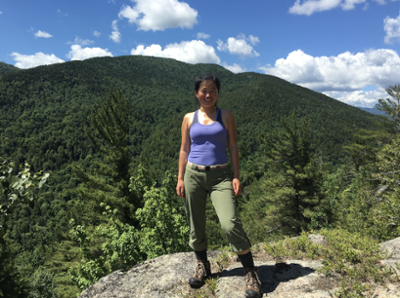Hongying Sun
Graduate Student, The Mathews Lab (URMC)

You work in a laboratory. What are you currently researching?
I’m a computational biologist, and I work on building thermodynamic models of RNA secondary structure. RNA is central to life, because it can carry genetic information, act as a template for protein synthesis, and catalyze chemical reactions. These many capabilities lead to the idea of an early “RNA world” where RNA perhaps represented the first primitive life. Moreover, it is also now known that in modern cells, RNA performs a variety of critical biological functions besides encoding proteins.
Using a thermodynamic model of RNA structure called the nearest neighbor model or the “Turner rules”, after Prof. Doug Turner from the Department of Chemistry, we can predict how an RNA will fold using only its sequence, giving important clues to its function. This capability has been proven useful for predicting the roles of RNA molecules in cells, understanding how mutations in RNA can cause disease, designing RNA devices that perform new functions, and designing drugs that target RNA. However, the thermodynamic model is derived from experiments on a relatively small set of sequences. My work attempts to identify the model parameters that are most important, which will identify opportunities for further experiments to improve the model, increasing the accuracy of structure prediction. I also work on discovering new parameters that might be necessary to improve model accuracy.
What do you enjoy most about working here at the U of R?
It has to be my research -- I can’t say enough how much I love my research. I always enjoyed math as a kid, but never pursued it seriously. Now, trained as a computational biologist, I get to study biology, programming and statistics at the same time. It’s the most fulfilling and rewarding experience ever. And I don’t just work by myself in a vacuum; my research projects have brought me into contact with so many brilliant colleagues who I never would have met otherwise.
What’s the most important thing that you’ve learned working here and/or studying biology?
Know my weaknesses and strengthen them. It is easy to find out what we are good at, and for me that’s presenting and talking about my work, which is one of my favorite things to do. Sometimes I can even feel myself glowing when I give presentations on my own research.
However, it is my weaknesses that limit me. The talks go well, but I sometimes have trouble in answering questions afterward. Sometimes, I misunderstand a question and end up answering something completely different from what was asked. Now I take the time to ask others to repeat their questions if I think I might have misunderstood. This is terrifying to do, but ultimately it’s necessary and really helps me appreciate others’ insight.
How do you unwind when you’re not in the lab?
I work out a lot! Exercise is my coffee. I feel energetic and ready to get back to my to-do list after a workout. My favorite exercise is running, but I also do a lot of fitness classes through the university fitness center. My favorite is Abs of Steel, which is tremendously painful but the core strength that it develops makes sitting in front of a computer all day tolerable. I enjoy stretching and I practice yoga regularly.
Besides exercise, I love reading books on psychology and philosophy, hoping that it might make me wiser. Friends are important, and I hang out with my friends on weekends and during holidays. I work hard and play hard – even my relaxing takes a lot of effort!
What is one thing about yourself that you’d like more people to know?
I am a shy person, as confirmed by Diane Cass, a former biology librarian who retired on July 15th, 2015. I was astonished when she told me that she knew I am shy. I knew I am shy, but didn’t expect others would notice. I asked how she found out. Her answer was hilarious and amused me a lot and it still does. “Shy people recognize shy people!” But having said that, I do enjoy talking to people and having conversations. It just takes courage!
